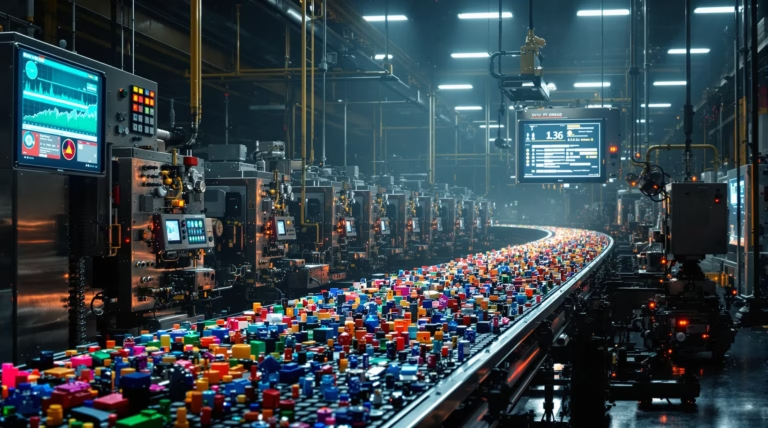Discrete Manufacturing: Key Concepts and Insights
Discover how discrete manufacturing revolutionizes modern production processes by creating distinct, traceable units that meet precise specifications and customer demands. Let’s explore the key aspects of this manufacturing approach and its impact across various industries.
Understanding Discrete Manufacturing
Discrete manufacturing is a production process focused on creating distinct, countable items that can be individually identified and tracked. Unlike other manufacturing methods, it involves assembling specific components to produce finished goods such as automobiles, electronics, and machinery. Each product created through discrete manufacturing exists as a separate unit with its own identity and characteristics.
This manufacturing approach is particularly valuable for industries requiring customization and specific product configurations. The ability to produce items in individual units or small batches makes discrete manufacturing ideal for companies that need to track each product throughout its lifecycle. As consumer demands for personalized products continue to grow, discrete manufacturing has become increasingly important across various industrial sectors.
Characteristics of Discrete Manufacturing
- Individual unit identification and tracking capabilities
- Structured assembly line processes with specific stations
- Customization flexibility for specific customer requirements
- Complex supply chain management
- Rigorous quality control systems
- Component-based production approach
Discrete vs. Process Manufacturing
| Aspect | Discrete Manufacturing | Process Manufacturing |
|---|---|---|
| Output Type | Distinct, countable items | Bulk products |
| Production Method | Assembly-oriented workflows | Continuous or batch processes |
| Customization | High flexibility | Limited flexibility |
| Example Products | Smartphones, vehicles | Chemicals, beverages |
Key Industries in Discrete Manufacturing
Discrete manufacturing spans numerous sectors where the production of distinct, identifiable items is essential. Several major industries have adopted this manufacturing approach due to its flexibility and ability to create customizable, component-based products. The automotive, aerospace, electronics, industrial machinery, consumer goods, and furniture manufacturing sectors all heavily rely on discrete manufacturing processes to meet specific customer requirements and produce complex finished products.
Automotive and Aerospace Sectors
The automotive industry represents one of the most prominent applications of discrete manufacturing principles. Vehicle production involves assembling thousands of individual components into a single functional unit, with each car or truck being a distinct, traceable product. Modern automotive manufacturing combines automation with precise assembly techniques to produce vehicles that can be highly customized while maintaining consistent quality standards.
Similarly, aerospace manufacturing relies heavily on discrete production methods to create aircraft, spacecraft, and their components. This sector faces even more stringent requirements than automotive, with extraordinarily high precision tolerances and safety standards. Aerospace manufacturers must track each component throughout its lifecycle, often for decades, making the discrete approach essential. The industry’s production runs are typically smaller than automotive, but the complexity is often greater, with some aircraft containing millions of individual parts.
Electronics and Furniture Production
Electronics production represents discrete manufacturing at its most intricate level, involving the precise assembly of miniaturized components into sophisticated devices. This sector manages complex challenges including rapid product lifecycles, global supply chain coordination, and increasing customization demands. The discrete manufacturing approach enables manufacturers to adapt swiftly to technological innovations while maintaining strict quality control measures. Component traceability becomes particularly vital in electronics, where identifying and isolating defects can prevent costly recalls.
- Short product lifecycles requiring rapid adaptation
- Complex global supply chain management
- High-precision assembly requirements
- Strict component traceability needs
- Advanced quality control systems
Furniture manufacturing, while less technically complex, demonstrates another vital application of discrete production methods. This sector combines traditional craftsmanship with modern automated processes, working with diverse materials including wood, metal, plastic, and textiles. The discrete manufacturing approach enables furniture makers to offer extensive customization options while maintaining efficient production schedules. As consumer demand for personalized furniture grows, manufacturers leverage discrete processes to balance unique product creation with cost-effective operations.
Role of ERP Systems in Discrete Manufacturing
Enterprise Resource Planning (ERP) systems serve as central command centers for modern discrete manufacturing operations. These comprehensive platforms have evolved from basic manufacturing resource planning tools into sophisticated systems that integrate multiple business functions. In discrete manufacturing, ERP solutions provide essential capabilities for component tracking, assembly management, and production schedule optimization while minimizing waste and production time.
- Inventory and materials management for thousands of components
- Sales order management handling customer specifications
- Supply chain coordination with multiple vendors
- Financial management and cost control
- Customer relationship management integration
- Production schedule optimization
Customization and Implementation of ERP Solutions
| Industry | Specific ERP Requirements |
|---|---|
| Aerospace | High-value component tracking, extended lifecycle management |
| Automotive | Complex production scheduling, assembly line coordination |
| Electronics | Enhanced quality control, rapid product iteration |
The deployment landscape for ERP systems continues to evolve, with manufacturers increasingly adopting cloud-based or hybrid solutions. These modern implementations offer enhanced flexibility, reduced IT infrastructure costs, and improved accessibility for distributed teams. When selecting an ERP solution, manufacturers must evaluate their current operations, future growth plans, and system scalability requirements. Leading vendors like SAP, Oracle, Microsoft, and Epicor provide specialized solutions adaptable to various discrete manufacturing environments.
Routing and Work Centers in Manufacturing
Routing represents the predetermined path a product takes through the manufacturing facility, defining the precise sequence of operations required to transform raw materials into finished goods. Each routing specification details the exact steps, their sequence, and the work centers responsible for performing them. Well-designed routing plans coordinate material flow, machine utilization, and labor allocation throughout the production process. They provide manufacturing teams with standardized procedures that ensure consistency while optimizing production efficiency.
- Precise sequence mapping of production operations
- Coordination of material flow and machine utilization
- Labor allocation optimization
- Standardized procedure implementation
- Quality control integration points
| Work Center Type | Primary Functions |
|---|---|
| Machining Centers | Initial component forming and cutting operations |
| Assembly Stations | Component integration and sub-assembly creation |
| Testing Facilities | Quality verification and performance validation |
| Finishing Areas | Painting, coating, and final product preparation |
Work centers form the physical foundation where routing plans come to life. These specialized stations or areas within the manufacturing environment focus on specific production tasks—from initial machining and forming to assembly, painting, testing, and packaging. A work center might consist of a single machine, a group of related equipment, or an entire production line staffed by specialized personnel. Each work center typically maintains its own capacity constraints, setup requirements, and operational parameters. By strategically organizing production through well-defined work centers and routing paths, discrete manufacturers can minimize material handling, reduce production time, optimize resource utilization, and maintain consistent quality standards across their operations.







